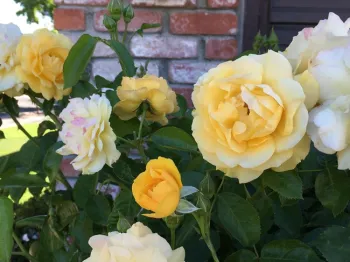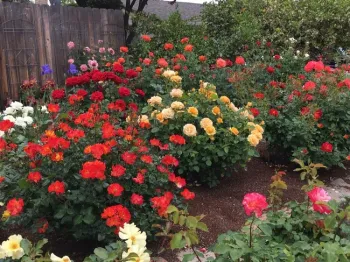Growing Healthy Roses
I once thought that roses were too demanding and prone to problems, but my husband loved them and convinced me they were not. We now have more than 30 healthy roses. Many rose difficulties can be controlled with careful selection of plant varieties and management of growing conditions.
Hybridized floribunda and landscape (shrub) roses, which have many blooms, generally have better disease and insect resistance than hybrid tea roses, which have fewer but larger flowers, although there are exceptions. When adding new roses to the garden, it helps to research rose ratings. The All-American Rose Society (AARS) tested rose cultivars beginning in 1939 and gave awards from 1940-2013. Many AARS All Star winners are still available and are generally attractive and disease resistant plants. The Julia Child rose in the Flower Garden at the San Joaquin County Demonstration Garden is an example of an AARS winner.

The American Rose Trials for Sustainability (ARTS) began testing roses in 2015 and gave its first awards in 2017.
They test in nine different climate zones over a two-year period. The San Joaquin County Demonstration Garden is the site of one of two Mediterranean Climate rating sites for ARTS. Karrie Reid, our Environmental Horticultural Advisor, has trained Master Gardeners to evaluate the roses according to a set criterion, and they are evaluated twice a month for two years.
Cultural Practices
Roses do best with 6 hours or more of direct sun. In the hot Central Valley, protection from late afternoon sun is desirable but not required. It is also best to locate them so they are exposed to good air movement, which includes planting them far enough apart. This helps reduce disease susceptibility. Roses are happiest in well-drained neutral soil (ph 7.0), although some roses tolerate less than ideal soil conditions better than others. The soil can be amended with compost when planted to improve drainage.
In California's Central Valley, roses need irrigation. Drought stress can lead to defoliation and cane sunburn and may contribute to spider mite problems. Overwatering or poorly drained soil, however, can lead to root diseases and nutritional deficiencies. Frequency and duration of irrigation will depend on weather conditions and soil texture, but twice weekly irrigation during the hot summer months should be sufficient. The top portion of the soil should be allowed to dry out before rewatering. Mulches help decrease water loss and will also help minimize weeds.
Roses generally need fertilizer, mainly nitrogen, but excessive nutrients may limit rose growth if the salt level becomes too high, as roses are not salt tolerant. Fertilization twice per year should be sufficient. This may only be necessary if there are symptoms of nitrogen deficiency, such as poor growth or chlorosis of the lower leaves. A slow-release fertilizer can be used, following the package directions carefully. For sandy soils, it may be best to split the application into two parts, one month apart. If there are signs of deficiency of the micronutrients iron and zinc (interveinal chlorosis of new leaves), iron and zinc supplements can be applied to the foliage according to directions.

Pruning is important and is generally done in January to remove dead and crossing canes, remove top growth, and to produce a vase-shaped configuration, which allows good air circulation. It is also important to remove all leaves and debris to reduce overwintering insects and diseases. In summer, dead or crossing canes can be removed at any time. Roses benefit from deadheading, or removing spent flowers, which allows the plant to conserve energy and produce more flowers. Blooms and spent flowers should be cut above the first outward facing five-leaflet set of leaves for first-year plants, and somewhat lower for established plants.
A Few Common Diseases
Powdery mildew is caused by a fungus and produces white-to-gray powdery growth on both sides of leaves, as well as on shoots and buds. Overhead irrigation or washing at midday may limit the disease by disrupting the spore-release cycle, but there must be time for the foliage to dry before evening. It is also best to avoid wetting the leaves if it is very hot, to avoid burning from water on the leaves. It is important to remove and dispose of all leaves of the winter pruning to limit infestations. Some roses are much more resistant to powdery mildew than others. Landscape (shrub) varieties are among the most resistant, as well as roses with glossy leaves. Plants grown with good air circulation in a sunny location are less likely to have powdery mildew problems.
Rust is also caused by a fungus and prefers cool, moist weather. Rust looks like small orange pustules on the underside of leaves and causes leaf drop. For plants infected with rust, avoid overhead watering and prune back severely affected canes. Dispose of all leaves in winter pruning.
A Few Insects
Aphids are the most common rose pest. They are normally only present in spring and early summer. They prefer rapidly growing tissue such as buds and shoots. Low to moderate levels do little damage, while moderate to high populations secrete large quantities of honeydew resulting in the growth of sooty mold, as well as ant colonies protecting them. Very high numbers may distort or kill buds. Aphids have many natural predators such as lady beetles (ladybugs) and syrphid flies. Aphids can be knocked off early in the morning with a forceful spray of water or controlled with insecticidal soaps or neem oil if necessary. Using more toxic systemic pesticides is harmful to natural predators.
Spider mites may become a problem in dry, dusty conditions. These small mites (the size of a period) cause stippling or bleaching of leaves and may cause leaves to fall off. They first appear on the underside of leaves and move to the upper side as populations increase. Some create webbing and some do not. Most insecticides are not effective and can cause their numbers to increase because they kill natural predators. Conserving natural enemies, sufficient irrigation and reducing dust help control mites. Periodic washing of leaves, especially the underside, can be effective in reducing populations.
Resources
There are many resources available to help keep your roses healthy. Here are a few:
Pub. 7465: Roses: Cultural Practices & Weed Control (http://ipm.ucanr.edu/PDF/PESTNOTES/pnrosescultural.pdf)
Pub. 7463: Roses: Diseases and Disorders (http://ipm.ucanr.edu/PDF/PESTNOTES/pnrosesdiseases.pdf)
Pub. 7466: Roses: Insects and Mites (http://ipm.ucanr.edu/PDF/PESTNOTES/pnrosesinsect.pdf)
You can also go to the University of California Integrated Pest Management website page on roses (http://ipm.ucanr.edu/PMG/GARDEN/PLANTS/rose.html) and from there click on various topics related to roses, including other diseases and insects not mentioned here.
Roses add a lot of beauty to a garden and are not that difficult to maintain. If you select carefully and make sure they have their basic requirements (sun, air circulation, water, fertilizer), they will provide you with both flowers for your home and a lovely landscape to look at. Enjoy!
